Alchemy is a bridge between Earth and Heaven, matter and spirit, the solid and the fluid, the visible and the invisible, bringing the horizontal and the vertical together.
—J. Ramsay1
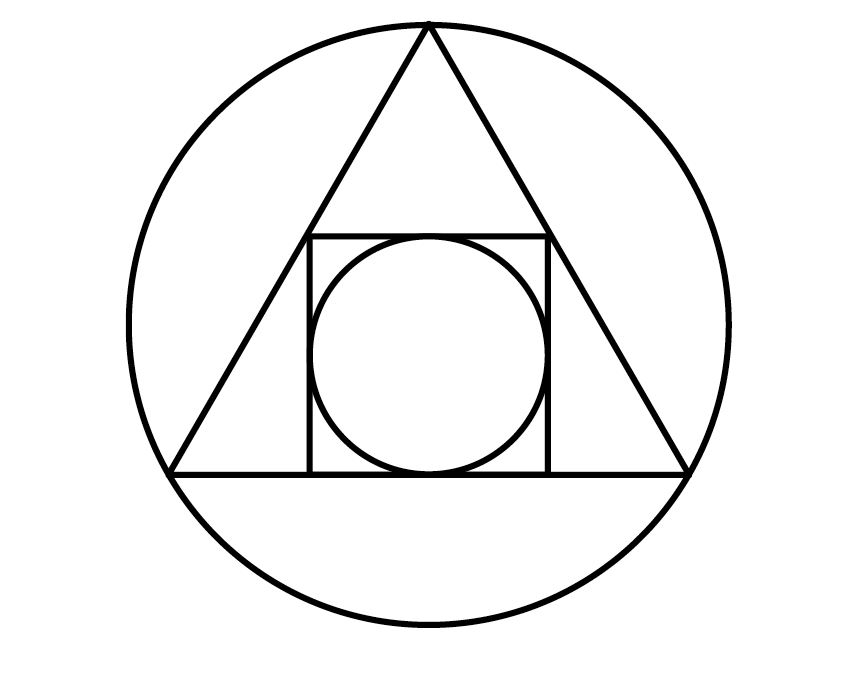
A symbol for alchemy: the void, activated by thought and purified by deity, makes the manifestation.
Alchemical Chant for Manifestation
Out of the black and into the red
out of the red and into the white
out of the white and into the gold
out of the gold and into the world.
Where my hand is laid, enchantment is made.
Out of the void and into the action
out of the action and into the spirit
out of the spirit and into the astral
out of the astral and into the world.
Where the gods’ hands are laid,
magick is made.
At the threshold of the Notre Dame Cathedral in Paris, the figure of the goddess of alchemy sits enthroned beneath the figure of Christ on the central pillar of the Porch of Judgment, her feet touching the ground, her head in the heavenly waters. In ancient cultures, the sky was associated with the waters of the cosmic birth mother. In one hand, Alchemy holds a scepter, and in the other, two books—one closed, one open. Against her body rests a nine-runged ladder.2 You may have seen this image before: She is the High Priestess of the Tarot deck, who stands for mysteries revealed and closely guarded secrets. She is the goddess of initiation. She is the transformation of the soul. Alchemy is none other than the Greek Sophia, whose name means “wisdom,” and who was worshipped by early Christians.
The Word
To discover what alchemy really means we have to look at the history of the word, which, like alchemy itself, is shrouded in mystery. Some believe that its origin is Arabic: al kimia, sometimes translated as “the black soil art” or “the Egyptian art.” This idea comes from the Egyptian word chem, meaning “black,” and also the Greek word chyma, which describes the casting or fusing of metals. Others believe that the word is related to the Hebrew chamaman, which means “mystery” in the sense that something occult or secret is not easily revealed.3 Since we know ancient Egyptians, Greeks, and Jews were involved in the practice of alchemy, any or all of these meanings could be correct. We also know that the idea of alchemy was present in ancient China before 2500 b.c., in India, and in areas of the Far East. What all this information tells us is that alchemy, like magick, was very much a part of the ancient world.
The History
There are two types of alchemy in the modern era, yet they are intricately related. The first kind of alchemy involves real science (think of the periodic table you learned about in school), which uses mathematical formulas and elements to create something interesting, like a chemical compound. In ancient times, the process of alchemy involved taking an element (a material thing like lead), purifying it, and then adding a bunch of stuff that turned the lead into something else entirely (like gold).4 It is thought that the early Chaldeans, Phoenicians, and Babylonians used this kind of science and did indeed manufacture real gold, but as we know with all things historical, there is always some debate, especially since our modern scientists have not admitted whether they have accomplished this feat or not. Some people believe that the ancients did discover how to turn a base metal (like lead) into gold, but that through history, the formula was lost. This type of alchemy, the science that studies elements and compounds, was practiced until the beginning of the eighteenth century, when the term “alchemy” was replaced by the word “chemistry.” Historical references also indicate that some of the first and foremost alchemists were women, specifically a “priestess of Isis” who wrote on the subject; an early scholar calling herself Cleopatra; a woman named Theosebia; Mary the Jewess (possible sister of Moses and sometimes called the Mother of Alchemy); and the female philosopher Hypatia (murdered in a.d. 415).5
There were quite a few alchemists running around during the Middle Ages. Some sought science, some sought faith, and others just wanted the gold. Alchemists were attached to both churches and royal courts. Since the practice was expensive and time consuming, most of them went broke unless they were doing side jobs to indulge the royalty (like spying and other interesting activities). Many times, however, royalty were slow to reimburse for services or did not bother to pay their debts at all. Did anyone ever turn metal into gold? Well, there is one that’s a possibility. Nicholas Flamel (1330–1418) claimed he had done just that by following an ancient manuscript, supposedly written by Abraham Eleazar, which contained a number of fascinating but baffling illustrations with some obscure text, possibly Greek.6 What makes his claim more credible than any other is that not long after he reported his success, he became amazingly rich. So rich, in fact, that by the time he died, he had endowed fourteen hospitals, three chapels, and seven churches in Paris, France, alone, not to mention his work in Spain.7
The second form of alchemy brings real magick into play, and I’m sure you’ve seen movies or read stories about wizards practicing alchemy. We call this kind of alchemy an esoteric study. Esoteric means “for the initiated only.” The word initiated means “to go through a special ceremony” or reach a divine truth. So, an esoteric study is a course of learning for people who are required (at some point in the learning process) to experience a unique ceremony, and from this learning and ceremony find the divine truth meant only for them. Witchcraft can be considered an esoteric study because those who practice Witchcraft often go through an initiation during their first year of study (depending on the group to which they belong) and, if they stick with it long enough, are transformed into better individuals because they have realized the divine truth as it is important to them.
Some people use the words divine alchemy8 to explain esoteric study. Divine alchemy comes from the Greek word dynamikos, meaning “energy in motion,” which says that by using different techniques we can mix our mental abilities with the energy of Spirit (creating a special light/vibration) that affects matter and causes change in the physical world. In plain English it means using your belief in god/dess with your thoughts to change the world around you, and your certainty (faith) that the change is possible. If this is not your first book on the occult, you will have read about changing thought into form before, and that all thoughts are things. Indeed, almost every Wiccan, Pagan, New Age, or spiritual self-help book on the market today strives to teach you how to use your mind to create positive change in your world. Not exactly a religion in its own right, divine alchemy became part of various mystery traditions over the ages (teachings that weren’t given to just anybody), and traces of this kind of alchemy lurked in secret societies. Moses, Roger Bacon, St. Germain, Leonardo da Vinci, Isaac Newton, and Victor Hugo, to name a few, were all considered alchemists.9 Therefore, every magickal person who truly seeks to make themselves and the world a better place through their actions, studies, and thoughts is practicing a form of alchemy. You can tell how advanced they are by their actions and bearing—meaning that if they act like a jerk, are rude, or focus on hurting someone in thought, word, or deed, they are basically nothing but hot air masquerading as the real thing.
Unlike today, with thousands of books flooding the market on how to mentally program yourself to reap the most benefits out of life, the alchemical symbols found in old manuscripts were not written to inform the world how to change thought into form. They were created to help initiates of secret societies focus on the spiritual realms by giving them a visual aid—think of magickal flash cards and you’re on the right track. By meditating on the symbols and using them in ritual, the students learned how to be better people. This process of self-transformation was called the Great Work or Magnum Opus. The Great Work—your spiritual rebirth—has two parts: learning to become a spiritual person, and then using what you have learned to effect change in the world. Modern Witchcraft is just such a process!
In the Craft you are expected to learn mastery over chaos (and it takes time). This chaos in alchemy is called prima materia, meaning “first matter.” It is the essence from whence all things were born, and is the raw material from which you can create anything. It is the material of the mind. It is thought itself. It is the cosmic sea, the subquantum level. The second part of the Great Work involves taking that thought (or chaos) and fine-tuning it inward to create a pure body of light—your spiritual rebirth, from which you can transform yourself and the world around you. When a Witch Draws Down the Moon, he or she is taking part in an ancient alchemical ceremony geared to create change from within that will, in turn, change things without to match the Witch’s desire. If the desire is not pure, then the process is fouled.
Studying alchemy (magick) requires practice, and the student must work slowly through several mental and physical purifying steps to reach a specific goal. Esoteric alchemical studies in-clude breathing exercises, meditation, visualization, reading auras, astral projection, psychometry, telepathy, remote viewing, and more. The ultimate goal is to reach a mental place of pure power called the philosopher’s stone, which is the key to turning thoughts into things in a controlled way. The philosopher’s stone is the crossroads, the journey to the subquantum level of existence. To some, the philosopher’s stone is not a real stone like you find in the ground, it is a mental key, a way of knowing how to think that makes things happen, literally turning thoughts into things. It is also believed that not only can you use your mind in directed, focused steps to create matter (such as gold and silver), you can also produce a universal medicine for all diseases. If you have read about quantum physics in the Magick section of this book, then right about now you are seeing a major parallel.
Gold, then, was what the alchemist strived to create, definitely mentally and in some cases physically. It was believed that if you could penetrate the mysteries of space, time, and matter by unlocking the secrets of how a substance is put together, then you could reach conscious transformation as well. The body of light was considered the root of the universe, and if we could perceive the mystery of this light, we could change anything. (Again, quantum physics revisited.) To the ancients, gold, representing this body of light, was the symbol of the eternal, radiant light of the spirit, and the transformation10 through the colors of black (chaos), red (the dawning of information and change), white (purification), and gold (ultimate transformation) became the symbolic colors of the alchemist. Although at first we may think that the color black is bad, the symbology of the color is far from negative. Black, the color most often associated with wisdom in ancient cultures, represents the dark phase of the lunar cycle (a portion of the fourth quarter moon), where preparation is made for the coming birth of the next cycle. It is a time of looking within, of finding the wisdom one needs to build a bright future, the darkness of the womb of the Great Mother, and the place of germination of the greatest human ideas. Moving from black to red to white to gold speaks of the ultimate magickal journey. Watch a sunrise sometime and you might visually be able to understand what the alchemists were saying (depending, of course, on weather patterns and atmospheric phenomena). Every once in a while you will see a sunrise that bleeds from black to the reddening of the heavens, to pure white light, to a golden glow. This is the ceremony of the dawn.
Now do you know where Einstein got his ideas and what he was shooting for?
The hexagram, caduceus, and the pentacle (below) were among those symbols used to train these students of alchemy.11
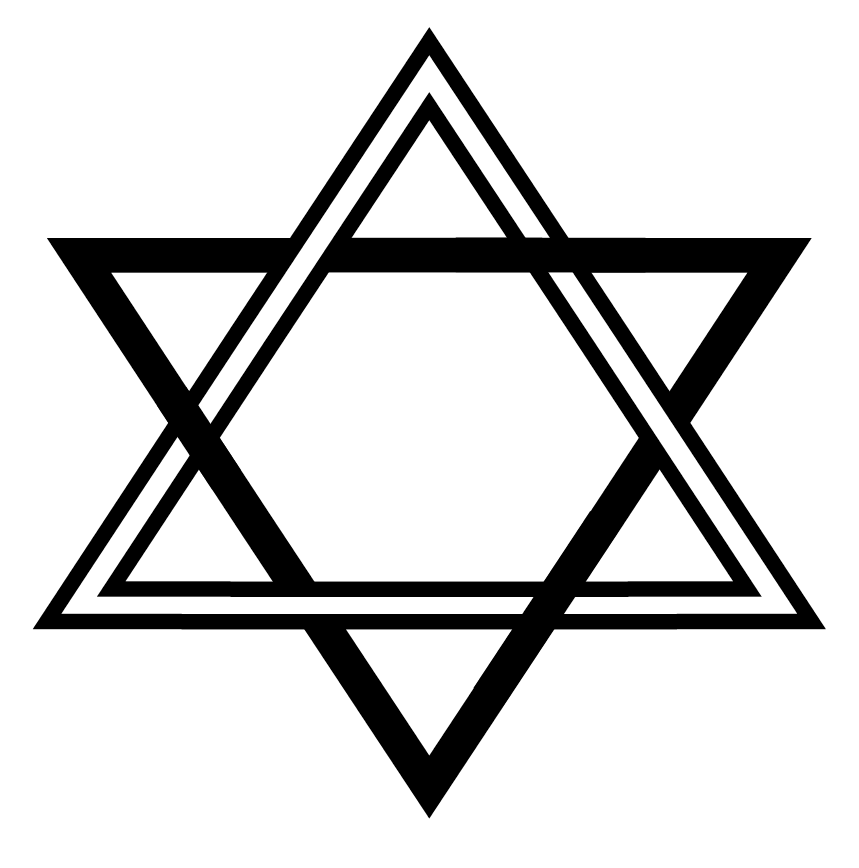
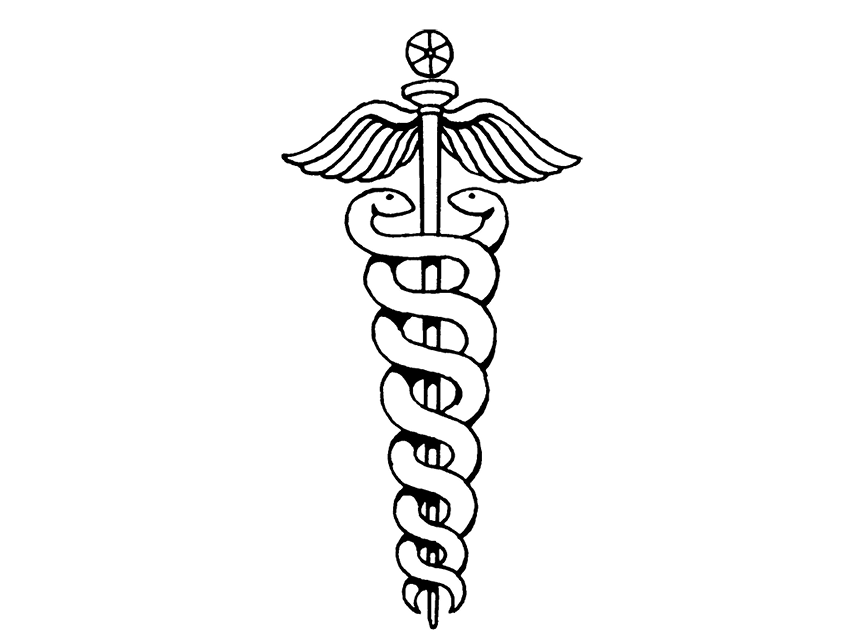
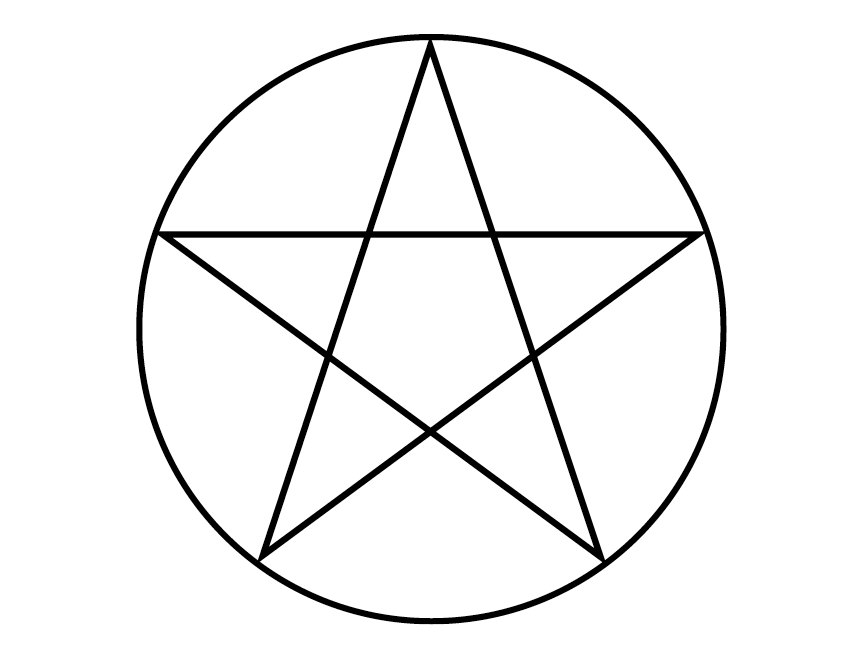
Today, each of these symbols still carries part of their original meaning and you will find them discussed in various areas of this book.
If alchemy (magick) had not been for “the select few,” history as we know it would not exist; indeed we, as humans, may (as a collective) have reached a more enlightened state by now. Then again, maybe not.
Although alchemy was well known in the Byzantine and Muslim worlds, Europe only experienced the practice in fragmentary form until around 1144, when Robert of Chester translated Arabic texts found in Spain to Latin. This presented the first alchemical documents to the European reader12 as a direct result of the Crusades, which was not exactly the best of times to bring occult knowledge to his fellow Europeans, given the struggles of the Christian church for world rule. This doesn’t mean Europeans didn’t work with the idea, but it certainly put a cramp in their style, and by 1317 Pope John XII presented yet another papal document condemning the practice.13 The goddess Alchemy reigned, however, moving subtly into the strength and power of the Christian Mary, and finding a seat on her very own throne in the Cathedral of Notre Dame in Paris. At the same time, a philosopher by the name of Ramon Lull introduced the words “first matter” (argent vivre) and related it to the four elements we find so familiar in magickal studies (earth, air, water, and fire). Lull added the fifth element, which he called “quintessence,” meaning Spirit or Heaven. Unfortunately Lull was stoned to death by Moslems when he arrived in Africa, much like Hypatia, who was stoned by the Christians almost 100 years before.
Alchemy, Psychology, and Magick
Magick, in its own way, is a science of psychology because it uses the power of the mind to bring forth change in one’s life. Interestingly enough, at the turn of the twentieth century, those who dabbled in psychology and matters of the mind were also those who were interested in the occult sciences (Fortune, Blavatsky, Regardi, etc.). At that time, psychology was a new, suspicious interest to the world at large. It was Carl Jung who propelled the sciences of the mind into our daily lives and forced the scientists and medical people of the times to pay attention to this amazing facet of human nature. Jung be-lieved that alchemists were projecting or seeing their own unconscious, and he wrote reams of material on dreams, human behavioral patterns, and the mind in general in relation to his own alchemical studies. Thanks to Jung’s work, psychology is here to stay.
Magick Pictures:
Alchemical Symbols
Many of the symbols used in current magickal practices are linked to alchemical designs of the past. Historians have found strong links between alchemy, astronomy, astrology, and magick. For example, long ago, only five planets were proven to exist (Mercury, Mars, Venus, Jupiter, and Saturn) and two luminaries (sun and moon). I say “proven” because even in medieval astrology/ astronomy there were ideograms (word pictures) that suggested there may be more planets in our solar system. Each of the five known planets were associated with an element, and each astrological sign (Aries through Pisces) spoke of an alchemical process. Sound familiar?
With the information you have already read, you now know that an alchemical process is a mental one that involves daily meditations, learning to focus (concentrate), and practicing magick and ritual regularly. Many magickal people today still use those alchemical symbols (magick pictures) to work magick. But what do all those pictures mean? In ancient alchemy, the sign of Aries, for example, meant to reduce something by the use of heat. Mixing the signs and planets together, the alchemists made symbols to represent chemical compounds and/or esoteric philosophy. On one hand, the pictures spoke of a chemical scientific formula. On the other hand, they meant a way of thinking. The symbols were a shorthand or code and, over time, the code became interchangeable between scientific alchemy (chemistry), astrology, astronomy, and divine alchemy (or magickal practices). Therefore, it isn’t the symbol itself that carries the power of change, but how you use that symbol in your daily and magickal life. Symbols, whether scientific or magickal, represent formulas for change. Many of the symbols and philosophical ideals currently used in the Craft can be traced to the practice of alchemy, including many of the tools found on our altars.
Alchemical ideograms (symbols or drawings that illustrate an idea or concept) aren’t the only signs or sigils you’ll find in the Craft. Interestingly, the word symbol comes from the Greek word symbolon, and describes the practice of breaking a piece of clay into several pieces and handing a piece to each member in a group for safekeeping. Later, when the group reunited, they would match the pieces together to make sure that everyone present was actually a member of the original group. This practice was used by the ancient mystery traditions to ensure that nosy busybodies didn’t sneak in with the serious students at important gatherings and rituals. Today, when we see people wearing the same symbol (cross, pentacle, Star of David), we know that they belong to a particular group of people (in this case, a particular religion). This means they belong to a group mind, and we talked about that under the section on Group Mind and the Witches’ Coven in Part 1.
In the Craft community, various groups may design their own symbols, or put symbols together in a specific way to show that they all belong to an organization of like mind, or share a common magickal history. A few embroider the symbol (or set of symbols) on their ritual robes, on altar cloths, or paint (or sew) the symbol on a banner that hangs in the ritual room, at a Grand Coven event, or at Pagan festivals. These symbols are often ancient ideograms, and many find their roots in alchemy.
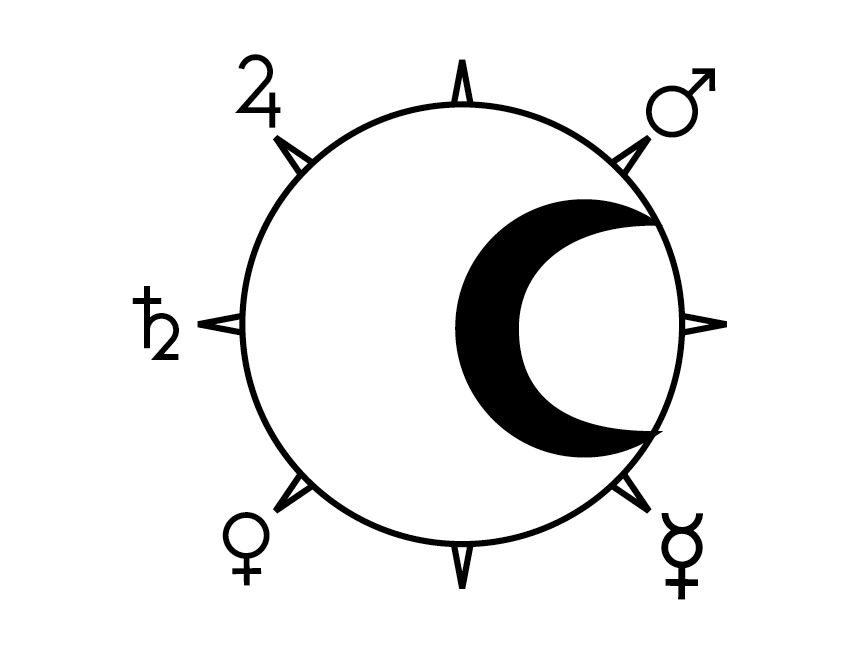
Understanding How Alchemy Works: Alchemical Elixir of the Moon
In medieval times, the word elixir meant “catalyst,” and when we hear the word today, we expect to see some sort of potion, or at least a liquid. In ancient times, however, an elixir didn’t mean a liquid at all, it simply meant a method of change—a formula not of liquid, but of words or drawings. I’m sure you’ve heard the words “mathematical formula” in school. See? The apple really doesn’t fall far from the tree. The symbol above, thought to be designed in the fifteenth century, is an elixir—a formula written on paper. When used properly, it can be a formula for change. The picture called the Elixir of the Moon is actually a model of our solar system, with the sun and the moon as the centerpiece, and the various planets (Mercury, Venus, Mars, Saturn, and Jupiter) on the outside, circling around the moon/sun. This particular symbol is interesting because there is room for the three planets Uranus, Neptune, and Pluto, discovered much later than the original drawing.
The eight triangles stand for the eight phases of the moon, the eight paths of Wiccan power (ritual, chanting, spells, aspecting deity, meditation, drumming, divination, and working with the dead), the eight High Holy Days (see part 1, Wheel of the Year), and the eight cardinal directions (North, Northeast, East, Southeast, South, Southwest, West, Northwest), as well as the eight planets in our solar system (Mercury, Venus, Mars, Jupiter, Saturn, Uranus, Neptune, and Pluto). The sun stands for male energy (the God), and the crescent moon links to female energy (the Goddess)—or you can exchange the symbolism, tying the female energy to the sun and the male energy to the moon, as practiced by some ancient societies.
When used for magickal purposes, the symbol above is also called a talisman (see Talismans in part 4 to understand exactly how this magickal operation works). When we use this talisman, we activate the powers of the sun (your will), the moon (your emotions), Mars (your ability to take action), Venus (your ability to love), Mercury (your ability to communicate), Jupiter (your faith), and Saturn (your ability to work within a structure without hurting anyone).
This symbol is an example of what divine alchemy (magick) is all about. Here, we will be using the picture to help us focus on our desire, and we will be using it for magick and meditation. To anyone who pages through this book and doesn’t read the explanation of the picture, the symbol appears to be a simple drawing, but you just learned that the picture speaks of several different magickal ideas. Look at the picture again while you read those magickal ideas aloud. They are: the eight High Holy Days of the Wiccan faith, the eight phases of the moon, the eight directional compass points, the dynamic energy between male and female (sun and moon), the idea of God and Goddess (Lord and Lady), the ten major celestial bodies (sun, moon, Mercury, Venus, Mars, Jupiter, and Saturn, with points for Uranus, Neptune, and Pluto)—all working together to become one.
Okay, you’ve started the divine alchemical process by associating thoughts and ideas to a symbol. What more do you see in that symbol? What does it mean to you? That is also part of the alchemical magick, or the process of change. Therefore, each magickal symbol you encounter can mean many things (not just what you perceive on the surface or what you are told). How you process the symbol in your mind is important too!
Any symbol, then, can be used on a variety of levels, some obvious and others not. Here, we can use the symbol of the Elixir of the Moon for any number of magickal operations, including requests for good health, healing, prosperity, protection, love, and so on. But what of the symbols in magickal writings that don’t carry a full explanation of what they are for, and what you can do with them? My best advice to you is be a magickal detective! If you don’t know what a symbol, or a deity, or a particular practice is for, or what its history entails, don’t use it in your magickal work until you do. It is as simple as that. A guy or girl off the street doesn’t walk into a hospital, boogie down to the operating room, and start cutting people open. He or she has studied the human body, learned how to use the tools of surgery, and mentally prepared him- or herself for the operation (we hope). You should think of yourself the same way. In the Craft, adults speak of being properly prepared. This is what they are talking about: think, study, learn, grow—that’s all a part of the Witchcraft experience.
Gee, that sounds like a lot of work, doesn’t it? Well, it is. But it’s worth it. What will happen if you aren’t properly prepared (meaning zapping without the study part, and being mature enough to work for positive things rather than being immature and working for negative stuff)? Honestly? The ground will not gobble you up, nor will demons dance about your bed as you try to get a good night’s sleep, nor will your little sister be possessed (sorry) by the spirit of your great-aunt Milly. Nah. Spirit is incredibly forgiving about these things. Instead, you’ll fail. Simple as that, over and over again, until you give up, and then you’ll tell people that magick doesn’t really work, or you’ll hide your failures and tell others that only a chosen few should be allowed to work magick. Get it?
Spell for the Holidays
The most stressful times of the year often revolve around family holidays, regardless of the country in which you live. Expenses are high, emotions are pulled to the breaking point, and responsibilities seem greater. If we look at the Christmas/ Yule season especially, we see that the sun influence rides through Sagittarius, the sign of expansion, spirituality, and excess (food, presents, etc.) right before the holiday season, but when the sun moves in to Capricorn (around December 21), the brakes go on and the panic turns to depression. At no other time in our modern lives do we see such drastic distinction between two sun signs: expansion versus contraction.
If you are a working teen and going to school, it seems like there isn’t enough time in the day to get everything accomplished. The family wants you to participate in family traditions, but you have a term paper to write, you want to spend time with your boy- or girlfriend, your job wants extra hours, and if you are involved in other school activities, the advisor seems to have a “me first” attitude. It’s no wonder that teens get sick or frustrated over the holidays! Whether you are in middle school, high school, or college, the demands on your time can become excruciatingly painful. Here’s a wonderful spell to lessen the angst over the holiday season.
Remember to check your divination tool before using any spell, then follow one of the ritual formats provided in this book to flesh out the Elixir of the Moon.
Supplies: The Elixir of the Moon, drawn in your own hand on a piece of white paper (if you can get white parchment from an art store or the art department at school, that would be even better); one black marker; a set of colored pencils; any one of the following selection of candles: bayberry (prosperity and good fortune), gold (success and prosperity), silver (psychism and success), red (to get things moving), or the all-purpose white (your candle selection is up to you. If you are not permitted to use candles, Spirit will understand). Your favorite incense; your favorite magickal oil.
timing: Perform on the full or new moon; on a Sunday or Monday; or in the planetary hour of the sun or moon; or when the moon is in the sign of Leo (you can find this out by looking at your magickal almanac). Don’t worry if the timing information of these spells appears complicated at first. If you don’t understand the planetary hours, or how the moon gets in Leo in the first place, don’t despair, just pick a Sunday or Monday to work your spell. Explanations on planetary hours and moon phases are found in Part3, underAstrology and Moon, respectively.
Instructions: Draw the Elixir of the Moon on the piece of paper. Repeat the Alchemical Chant for Manifestation three times (on page 360) while holding your hands over the drawing. Light the incense and pass the paper and the candle through the scented smoke, saying this statement of intent: “I manifest love, luck, happiness, and serenity over the holiday season.”
Rub your favorite magickal oil on the candle, and repeat the statement of intent. Light the candle, and again repeat the statement. Pass the piece of paper over the flame (not too close) and say the statement. With the colored pencils, color the sun yellow, saying: “I activate the good fortune of the sun.”
Color the moon with the white colored pencil, saying:
I activate the power of the moon, and draw toward myself love, luck, happiness,
and serenity over the holiday season.
With the red colored pencil, slightly shade the area around the symbol of Mars (![]() ), saying:
), saying:
I activate the energy of Mars to bring myself love, luck, happiness, and serenity
over the holiday season.
Using the blue pencil, color the area around Mercury (![]() ), saying:
), saying:
I open the pathway between myself and Spirit so that I may enjoy clear thinking and communicate well over the holiday season.
Using the pink pencil, color the area around Venus (![]() ), saying:
), saying:
I call forth the energy of universal love
to abide in and around me during
this holiday season, and beyond.
For Jupiter (![]() ), choose the green pencil. While coloring the area around Jupiter, say:
), choose the green pencil. While coloring the area around Jupiter, say:
I call upon the powers of clear vision
and expansion to bring growth to my good
fortune over the holiday season.
Use the purple pencil to color around Saturn (![]() ), saying:
), saying:
I work well with authority figures and my efforts will bring great rewards over the holiday season.
Take three deep breaths and hold the colored talisman in your hand, then write your name on the back of the talisman. Dot the scented oil under your name. Place both hands over the talisman and envision the holiday season you desire. Put the paper under the candle holder. Allow the paper to remain there until the candle has completely burned. Carry the paper with you in purse or wallet during the holiday season. If you feel that the energy is wearing down, repeat the statement of intent while holding the paper close to your heart. (see also As Above, So Below.)